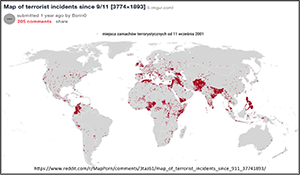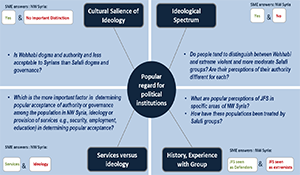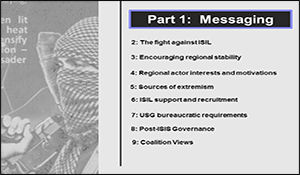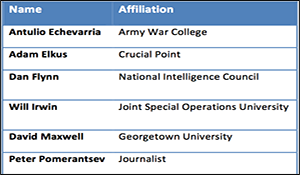
Views of Sunni and Shia Extremism
Question (R2 QL8): How does the U.S./Coalition view Shia extremism? Different from Sunni extremism? How do Sunni communities, Shia communities, MENA countries, and media perceive the U.S./Coalition position on combatting extremists? Author | Editor: Canna, S. (NSI, Inc). How does the U.S./Coalition view Shia extremism? How does the U.S./Coalition view Sunni extremism? Experts who volunteered […]
Continue Reading
Syrian Reaction to Salafi Institution
Question (R3 QL6): How will the population in northwest Syria react to future Salafist political institutions? Author | Editor: Astorino-Courtois, A. (NSI, Inc). Similar to points made by other contributors to this SMA Reach-back report, Dr. Kathleen Reedy of Rand includes a caveat in her response to the CENTCOM question. Given international pressure to avoid […]
Continue Reading
Discussion with NPS Experts – Jan 2017
SMA Reachback Panel Discussion with Experts from Naval Postgraduate School – Jan 2017. Author | Editor: Nicole (Peterson) Omundson (NSI, Inc.) Speakers were John Arquilla, Ryan Gingeras, Glenn Robinson, and Hy Rothstein of the Naval Postgraduate School. Glenn Robinson: Let me go over the agenda very briefly. As I mentioned yesterday Doc, unfortunately Craig Whiteside […]
Continue ReadingDiscourse Indicators of Gray Zone: South China Sea
Discourse Indicators of Gray Zone Activity: South China Sea Case Study. Author | Editor: Dr. Lawrence Kuznar, George Popp, & Nicole (Peterson) Omundson (NSI, Inc.) The increasing use of emotive themes and rhetorical devices (that amplify a message’s emotional effect) provide indicators of gray zone activities in speeches made by Chinese, Philippine, and Vietnamese government […]
Continue ReadingDiscourse Indicators of Gray Zone: Estonia
Discourse Indicators of Gray Zone Activity: Russian-Estonian Relations Case Study. Author | Editor: Dr. Lawrence Kuznar, George Popp, & Nicole (Peterson) Omundson (NSI, Inc.) The increasing use of emotive themes and rhetorical devices (that amplify a message’s emotional effect) provide indicators of gray zone activities in speeches made by Eurasian regional leaders and has the […]
Continue ReadingDiscourse Indicators of Gray Zone: Crimea
Discourse Indicators of Gray Zone Activity: Crimean Annexation Analysis Case Study. Author | Editor: Dr. Lawrence Kuznar, George Popp, & Nicole (Peterson) Omundson (NSI, Inc.) The increasing use of emotive themes and rhetorical devices (that amplify a message’s emotional effect) provide indicators of gray zone activities in speeches made by Eurasian regional leaders prior to […]
Continue Reading
Part 1 A Compendium of Messaging Reports
SMA CENTCOM Reach-back Reports – Part 1: Messaging. Author | Editor: SMA Program Office. This is Part 1 of a 9 part series of SMA Reach back responses to questions posed by USCENTCOM. Each report contains responses to multiple questions grouped by theme. At the request of United States Central Command (USCENTCOM), the Joint Staff, […]
Continue ReadingSyria Da’esh Insurgency
Question (R3 QL7): How does Da’esh’s transition to insurgency manifest itself in Syria; which other jihadist groups might offer the potential for merger and which areas of ungoverned space are most likely to offer conditions conducive for Da’esh to maintain some form of organizational structure and military effectiveness? Author | Editor: Polansky (Pagano), S. (NSI, […]
Continue Reading
Violent Non-state Actors in the Gray Zone
Violent Non-state Actors in the Gray Zone A Virtual Think Tank Analysis (ViTTa). Author | Editor: Sarah Canna, Nicole (Peterson) Omundson, & George Popp (NSI, Inc.) Using the Virtual Think Tank (ViTTa) expert elicitation methodology, NSI asked six leading gray zone experts whether Violent Non-state Actors (VNSAs) belong in the definition of the gray zone. […]
Continue Reading
ViTTa Assessment and Analysis of the Gray Zone
The Characterization and Conditions of the Gray Zone: A Virtual Think Tank Analysis (ViTTa) Author | Editor: Popp, G. (NSI, Inc). Within United States government (USG) and Department of Defense (DoD) spheres, the gray zone is a relatively new terminology and phenomena of focus for characterizing the changing nature of competition, conflict, and warfare between […]
Continue Reading